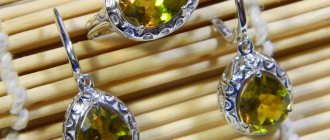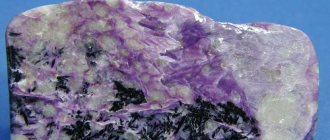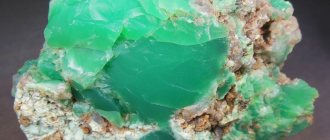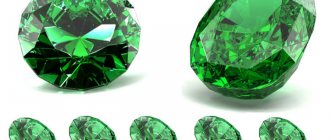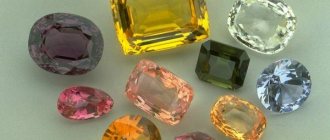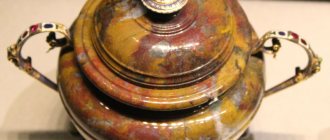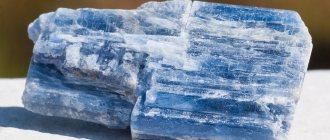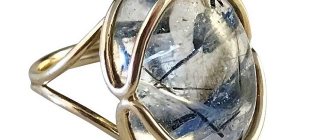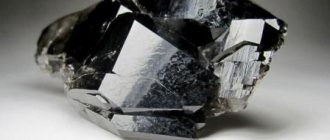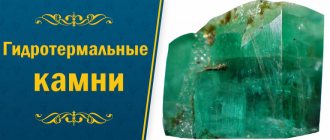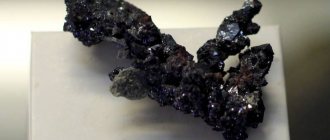Sultanite, the main deposit of which is located in Turkey, is a semi-precious mineral, but the cost is equal to a large diamond. A transparent stone that changes colors like a “chameleon” is valued by Arab sheikhs and wealthy people not only for its beauty, but also for its rarity.
The only deposit that produces gem-quality stones is Turkish; when it runs out, the cost of sultanite jewelry will skyrocket.
Description and uniqueness of the stone
A beautiful brownish-golden semi-precious stone that goes by many names and changes color like alexandrite. For mineralogists, sultanite is a watery corundum containing 85% aluminum oxide and 15% water.
Uncut natural sultanites
The degree of purity of jewelry crystals is high: inclusions are not visible even under a 10x magnifying glass.
However, there are impurities, they create the colors mentioned when describing the mineral:
- iron – yellowish-brown, ocher, marshy;
- manganese – pinkish-red, crimson;
- chrome – green.
Basic shades tend to change with different lighting conditions. This is the alexandrite effect. This characteristic of the stone makes it similar to alexandrite and amethyst. However, sultanite has a richer range of colors and softer tones. Plus mother-of-pearl reflections with glass shine.
| Other name | Diaspora |
| Formula | AlO(OH) |
| Color | White, brown, colorless, pale yellow, grayish-greenish-gray, lilac, pinkish |
| Stroke color | white |
| Shine | glass, mother-of-pearl |
| Transparency | transparent, translucent |
| Hardness | 6,5—7 |
| Cleavage | by {010} perfect; by {110} imperfect; by {100} very imperfect |
| Kink | conchoidal |
| Density | 3.2-3.5 g/cm³ |
| singonia | Rhombic (orthorhombic) |
Hardness on the Mohs scale 6.5–7. Natural stone is fragile and crumbles or cracks when heated or otherwise exposed.
comments
Maria I bought jewelry made from this stone only because it sparkles and shimmers very beautifully.
I couldn’t even think that this stone had such properties. I don’t really believe in this, although I would like to. Katya An incredibly beautiful stone, I like it when it’s not very dark, then it shimmers much brighter. I had never read about its special properties before; it was very interesting to learn such information about it.
Katya This stone shimmers very beautifully, the jewelry turns out to be quite exquisite. Literally every stone has an unusual story, so I wasn’t even surprised that the sultanite also has one.
How the name came about
Among professionals and at the everyday level, the mineral is known by several names. Everyone has their own story:
- Diaspora . This is how it was christened by the Frenchman Rene-Juste Haüy, who was the first to describe the mineral. The pebble is so called because of its fragility (the ancient Greek word διασπορά - to dissipate, crumble). This is an international term.
- Sultanite . The Russian name indicating the “pedigree” of the stone: the Sultan ruled the Ottoman Empire (the old name of Turkey). Jewelry pieces of Turkish origin are also called zultanites.
- Thanatarite . Russian term applied to Ural minerals. At first they were called ferrous kyanite. Later renamed in honor of the Russian geologist Joseph Thanatar (lived 1880–1961).
The Sultanite is recognized as a symbol of Turkey. Russia can also be considered its homeland: the first pebbles were found in the Urals before the Turkish ones. However, their quality is not jewelry. China also claims the title of “parent”.
From the Ottoman sultans to the village of Diagon Ford
The story about the Sultan and the lucky concubine is very interesting (besides, this is not a legend, but a historical fact). But in fact, the stone was first discovered in Russia, at the end of the 18th century, near the village of Kosoy Brod, not far from Yekaterinburg. The discovered low quality diaspore crystals did not impress the stone cutters.
The mineral was studied by a Russian geologist, the founder of the Russian ore school, Joseph Tanatar. Russian mineralogists named the stone after him (thanatarine).
Jewelry value of the stone
The Turkish authorities do not advertise what the reserves of jewelry stone are and how many carats are supplied to the world market annually. Mystery plus a minimum of raw materials fuel the excitement around sultanite.
Faceted sultanites
The price on the global jewelry market is determined by weight, transparency and color:
- Weight. The price for carat and smaller specimens starts at $120 per carat. Two-carat ones offer to buy three times - four times more expensive. Three carats - twice as much. A four-carat specimen is 20 times more expensive than a carat.
- Color. The most expensive ones are green or brown with a pinkish tint. Individual pieces are valued higher than diamonds. Yellow-brown, amber - the main variety of sultanite, at an average price. The greenish-grayish classic of comparable parameters is half the price.
- Transparency. The cheapest ones are cloudy specimens.
Collectors and rich people understand the significance of the stone. They view natural crystals as an investment.
Who is the jewelry suitable for?
The sultanite gemstone is used only in jewelry.
Earrings with sultanite
Accessories can be worn by people of different ages, men and women:
- Regarding the color and size of the insert, the general rule for precious stones applies: the older the owner, the larger and darker the stone.
- Men can become like sultans by wearing rings with bright stones. This is an option for informal occasions such as a party. The official sphere requires restraint: darkish inserts of a tie clip, ring, cufflinks. Such options look elegant and noble.
The main thing is to choose the right color of the stone to match your clothes.
Compatibility
Bright, rich sultanite in jewelry is chosen taking into account the wardrobe or other decorations.
Wardrobe
Sultanite is appropriate with business-style or dressy clothes:
- Stones without a frame or in silver are good with plain clothes in cool shades. This way the color balance is maintained.
- Sultanite in gold matches outfits with golden or yellow tones. The stone will not be “noisy”, but it will not get lost either.
In any case, clothes need to be monochrome. A colorful outfit will reduce the value of jewelry.
Silver ring with stone
Other accessories
Sultanite jewelry is magnificent in itself. If you want to complement them with accessories with other minerals, it’s worth remembering what sultanite is combined with:
- Looks good with pearls, diamonds, aquamarine, and other white, black, blue or green transparent stones.
- Aesthetically, it “conflicts” with red gems (ruby, garnet, tourmaline, etc.).
- Problematic compatibility with semi-precious, heavy minerals.
The cool reflection of a silver frame, white gold or platinum makes sultanite inserts luxurious.
Things to remember
Sultanite is a chameleon mineral, that is, it changes color. Therefore, when choosing decorations, take into account the weather, time of day, and lighting conditions:
- Regardless of the base shade, yellowness will appear in the stone in the sun - from light amber to cognac brownishness;
- in artificial light, cloudy weather, or at dusk, the insert looks bright green.
Depending on the lighting, diaspores (sultanite) can show different shades and colors.
Such color metamorphoses cause trouble, but the result is worth it.
Color spectrum
Thanatarites that do not contain impurities are found in nature. They are completely transparent. Such stones are not considered valuable. They are of no interest from a jewelry point of view.
Colored stones are popular and in demand:
- Pink - include manganese.
- Amber, yellow-brown - contain iron.
- Different shades of green. Such samples contain chromium impurities.
Diasporas of greenish-pink and pink-brown shades are recognized as the most valuable in the jewelry world.
Assortment and cost of jewelry
The Russian jewelry market offers silver and gold jewelry with sultanite stone. The mineral is almost always artificial.
Gold segment
These are mainly rings, earrings, and pendants made of 585° rose gold.
Cost of products (thousand rubles):
- ring – 9–15;
- pendant – 3–6;
- earrings –14–32.
Sultanite inserts in gold are often framed with small diamonds or cubic zirconia.
Silver segment
The range of products in silver is more diverse than gold. High quality material (925°) and cubic zirconia as an addition are used.
Cost of products (thousand rubles):
- suspension – 1.5-3.7;
- ring – 2.3-3.9;
- earrings – 2.6–10.7;
- bracelet – 6.8-7.1.
In both sections, the price depends on the number of stones and the weight of the frame.
Ring with sultanite
Diaspora deposits
Some transparent sultanite is mined in Myanmar, Hungary, and the USA.
The main amount of the mineral is mined in the Anatolian Mountains, in the area of Lake Bafa, in the territory of the former Ottoman Empire.
Sultanites are found in Russia, near Yekaterinburg, Azerbaijan, Uzbekistan, China, and Kazakhstan. However, only Türkiye produces on an industrial scale. Its gems are of the best quality.
We are proud: in the Perm region, at the Saranovskoye chromite deposit, purple crystals of rare beauty are found.
How to care for stone
It is no coincidence that the stone of diaspores has another name. Sultanite splits or cracks under the influence of even moderate force. Therefore, delicacy is required when using and caring for it.
Otherwise, you need to care for it like other precious minerals:
- protect from grease, sweat, dirty fingers, aggressive household chemicals;
- wash with cool water and a mild detergent;
- wipe with a soft cloth.
Store sultanite accessories separately from others.
How to determine the origin of a stone
Manufacturers offer natural stone or a synthetic analogue. There are no refined sultanites: it is impossible to improve the stones due to their fragility.
Signs of real sultanite help to distinguish a fake:
- alexandrite effect;
- pearlescent shimmer;
- delicate pastel colors.
The color is bright to the point of loudness, the absence of color change means a fake.
The official market is filled with synthetic analogues of two types:
- Stone created by hydrothermal method. Origin from Turkey. The properties are similar to natural ones, the details of the technology are a mystery.
- Nanosall from Russia. Crystals using nanotechnology are created by the company RusGems. The result is superior to the natural original in all respects: any color and dimensions, the highest transparency, there is no talk of fragility.
It is easy to distinguish a real pebble from an artificial one by price, if it is honest. Synthetics cost like garnet or topaz. On the tag or in the description there are almost always marks “g/t” (hydrothermal) or “ceramic glass”.
Fakes
There are different opinions about fakes. They even claim that everything is fake, regardless of whether it is a Turkish or Russian store.
The Turks grow artificial sultanites from aluminum gel at a temperature of 1700 C and pressure of thousands of atmospheres. At the same time, chips from real stones obtained as waste during cutting are added. They become the center of crystal growth. However, the Turks keep the technology of their production in the strictest confidence.
In Russia, glass-ceramics are more often produced with the full range of properties of natural stone, but at the same time they most often warn about their synthetic origin, adding the word “sitall” to the name “sultanite”.
It is almost impossible to distinguish an artificial stone from a natural sultanite, since having seen it only in a photo, it is simply impossible to imagine the play of colors of the gem from it.
Sultanite is a stone about which many recipes are told with descriptions of how to distinguish it from fakes, but apart from the unnaturally bright colors of fakes, all of them are doubtful. Even the alexandrite effect of fakes is quite at the level of natural gems.
Healing and magical effects
Sultanite is a young mineral, but has been studied by the magical community:
- Puts up a shield for external negativity: damage, envious people, brawlers.
- The stone has no “professional” specialization. The field of activity can be any, the main thing is that the person is an extraordinary, creative person. For them, a pebble or decoration will provide them with inspiration and the ability to solve problems in a non-trivial way.
- Those who like to quit what they started halfway or do something for years need to think carefully. The magic stone will “force” the owner to quickly bring projects to fruition.
- This is a useful gift for inveterate pessimists: the magic of an optimist stone will make them the same.
Any decoration can be a talisman. The magical properties of sultanite are enhanced by a silver frame.
High-grade gold is also suitable for framing. In a low-quality frame, the pebble becomes dull (“dormant”). They say that they used to check the authenticity of gold this way.
The healing properties of the stone are small; for serious diseases it is not a panacea. But there are benefits: sultanite helps to get out of depression, relieve a minor headache or cold.
Magic beauty stone
A cracked or split pebble means future health or financial problems for a person.
Sultanite and Zodiac
Astrology believes that a stone according to the zodiac sign suits everyone:
- The favorites of the mineral according to the horoscope are the fiery triad. Aries, Leo or Sagittarius will become calmer and more balanced. The pebble will reduce their ambition. It will help awaken and develop abilities. Talented people are capable of becoming clairvoyants.
- Practical “earthlings” Virgo, Taurus, Capricorn will be even more scrupulous. On an emotional level, they are waiting for romantic acquaintances, a new look at their family or soulmate.
- The stone will nourish energetically weak Pisces, support insecure Cancers, and soften sarcastic Scorpios.
- The energy of restless Libra, Aquarius, and Gemini will be directed in the right direction. For these zodiac signs, goals will become clearer and life will be more stable.
Representatives of any zodiac sign will receive positive changes in their fate from the Sultanite stone. Some will begin to assess the situation philosophically.
| Zodiac sign | Compatibility |
| Aries | + |
| Taurus | + |
| Twins | + |
| Cancer | + |
| a lion | +++ |
| Virgo | + |
| Scales | + |
| Scorpion | + |
| Sagittarius | + |
| Capricorn | + |
| Aquarius | + |
| Fish | + |
(“+++” – fits perfectly, “+” – can be worn, “-” – is strictly contraindicated)
